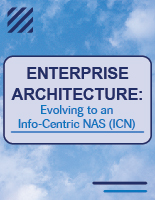
At the FAA, the sky is not the limit—it is just the beginning.
Exciting new opportunities are emerging in aviation and aerospace. Significant investments are advancing the research and development of autonomous vehicles, environmentally-friendly electric aircraft, high-speed and long-endurance solar-powered aircraft flying in the airspace above conventional fixed-wing aircraft, and new types of space vehicles. Success with these new technologies and vehicle types will introduce new ways to transport people and goods for large and small communities and also expand aviation’s role beyond transportation. The future National Airspace System (NAS) must accommodate the resulting changes in operations.
What is an Info-Centric NAS?
The future Info-Centric NAS seeks to address anticipated changes in aviation and aerospace while taking advantage of opportunities presenting themselves in business practices and technology. This includes accommodating increased diversity and number of operations within the NAS by the introduction of new extensible traffic management services while simultaneously bringing improvements to traditional Air Traffic Services. These changes will build upon the present-day NAS and enhance current capabilities while providing novel approaches for faster delivery of new capabilities. As new operations emerge, services and the infrastructure supporting these services must be agile and able to scale up for equitable access. The future is an Info-Centric NAS.
Pillars of Info-Centric NAS
The vision for the Info-Centric NAS builds on the Next Generation Air Transportation System (NextGen) foundation in three pillars: operations, supporting infrastructure, and integrated safety management.
![]() Operations in the 2035 NAS are characterized by collaboration among and within diverse traffic management services enabling the increased variety and number of new vehicles, missions, and operations. This collaboration is made possible through a fully integrated information regime with interoperable sharing of information. This can be leveraged to accurately estimate the current state and confidently predict the future state of the NAS. Increased agility in systems and services allows the NAS to adapt as needs evolve in unanticipated ways.
Operations in the 2035 NAS are characterized by collaboration among and within diverse traffic management services enabling the increased variety and number of new vehicles, missions, and operations. This collaboration is made possible through a fully integrated information regime with interoperable sharing of information. This can be leveraged to accurately estimate the current state and confidently predict the future state of the NAS. Increased agility in systems and services allows the NAS to adapt as needs evolve in unanticipated ways.
![]() Infrastructure increasingly leverages commercial assets, services, and new technologies in support of operations across diverse traffic management services. This public and private infrastructure delivers traffic management services that are ubiquitous (available everywhere and always), resilient to unanticipated changes, and agile to respond to future user needs. Where necessary, public/private partnerships are established to help ensure any unique government requirements can be met through commercial services and technologies.
Infrastructure increasingly leverages commercial assets, services, and new technologies in support of operations across diverse traffic management services. This public and private infrastructure delivers traffic management services that are ubiquitous (available everywhere and always), resilient to unanticipated changes, and agile to respond to future user needs. Where necessary, public/private partnerships are established to help ensure any unique government requirements can be met through commercial services and technologies.
![]() Safety Assurance for traffic management establishes tailored safety assurance to achieve acceptable safety based on operational characteristics. With big data, the NAS assures real-time safety through continuous monitoring, modeling, and verification to detect anomalies and correct for real-time spikes in risk. The compliance philosophy, including the use of the Safety Management System, assures each organization accounts for interoperability across a variety of new interactions including public vs private services, air vs ground systems, and automated vs manual control functions, all supporting increased diversity of operations.
Safety Assurance for traffic management establishes tailored safety assurance to achieve acceptable safety based on operational characteristics. With big data, the NAS assures real-time safety through continuous monitoring, modeling, and verification to detect anomalies and correct for real-time spikes in risk. The compliance philosophy, including the use of the Safety Management System, assures each organization accounts for interoperability across a variety of new interactions including public vs private services, air vs ground systems, and automated vs manual control functions, all supporting increased diversity of operations.
Delivering an Info-Centric NAS
Projects
These projects are a critical part of how we are planning to evolve toward an Info-Centric NAS.
Advanced Air Mobility

A new era of aviation is taking off. Advanced Air Mobility is an umbrella term for aircraft that are likely highly automated and electric. Learn more »
Automation Evolution Strategy

The FAA is using Automation Evolution Strategy (AES) to modernize its automation by adopting a services-based architecture, with emphasis on more timely development and delivery of new capabilities. In brief, AES enables an Info-Centric NAS. Learn more »
Multi-Regional Trajectory Based Operations

The FAA is collaborating with our global partners on multi-regional trajectory based operations to enhance strategic planning. Learn more »
Media
The FAA transforms research into reality. Shaping the future of flight and ushering in a new era of aviation. Fascinating to watch! Learn More »
Last updated: Monday, August 28, 2023



